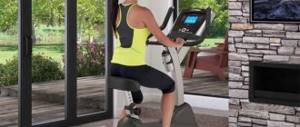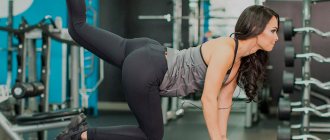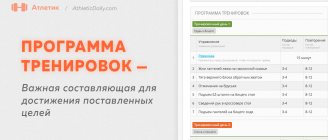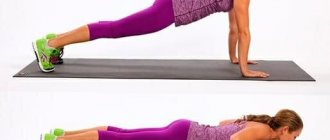What is cardio training
Cardio training is the performance of cyclic exercises aimed at developing the cardiovascular system.
Exercising temporarily increases your heart rate (HR).
By maintaining your heart rate in the desired range, you train general and muscular endurance, as well as burn energy.
Spending extra calories is the main reason to use cardio for weight loss.
The most common cardio exercises include:
- Walking
- Run
- Bicycle (or exercise bike)
- Swimming
- Orbitrek
- Stepper
- Rowing
They are called aerobic, since when performed, the aerobic energy supply mechanism is activated, that is, with the participation of oxygen.
Rules for effective cardio training in the gym for men
Principles that men must follow when training:
- It is important to take time to stretch and warm up your muscles, tendons and joints to minimize the risk of injury.
- Recovery between cardio workouts is 2 days.
- You should not expect instant changes in the body - the effect of the exercises will be visible only after 2-4 weeks of exercise.
- Do not neglect high-intensity loads , as they significantly speed up the metabolism.
- It is better to exercise outdoors . The more oxygenated the blood is, the faster the processes of fat oxidation in the body will occur.
- It is optimal to do cardio training after doing strength exercises , this promotes fat burning.
- The process of burning fat will begin only when you combine a competent approach to training with the right diet.
- The use of intervals of heavy loads and weak ones is of great benefit
- start training no earlier than 2 hours after a full meal in order to exclude the possibility of dyspeptic disorders due to increased stress on the body.
- Monitor your heart rate and do not allow it to get too high ( above 180-190 ), this is harmful to your health.
Exercises
- Running and fast walking
Running is a great way to oxygenate your blood and ventilate your lungs. You need to run at the optimal speed so as not to exhaust the body, but only tire it. The issue of correct technique is controversial: some recommend placing your heel on the support first, other researchers believe that this is one of the main causes of injury and it is better to start landing from the front of the foot.
But the second option is more preferable for intense running. The number of steps per minute should be approximately 90. Arms are bent at an angle of 90 degrees. It is advisable to purchase specialized running shoes in sports stores. You should run on level ground.
Photo 1. Exercise on a treadmill. On the simulator you can set the appropriate pace for training.
To practice your running technique, you can practice running in place or on a treadmill.
Walking is a safer and more accessible way to move and burn fat. With fast walking properly integrated into your training program, you can achieve no less success than running. In this mode, you need to cover about 10 thousand steps or 5-7 kilometers . Optimal fat burning is achieved with a heart rate of no more than 190 beats per minute.
- Squats
A basic exercise in bodybuilding and powerlifting, it is also used for cardio training. This exercise can be done only with your own weight or with an additional load (weights, barbell, dumbbells) - the choice depends on the physical development of the man.
Photo 2. Correct technique for performing squats. Arms are extended in front of you, legs should be bent at an angle of 90 degrees.
Squats use a large number of leg and back muscles and strengthen the cardiovascular system.
Optimal technique for performing the exercise:
- Feet shoulder width apart.
- The back is kept straight and not “rounded”.
- The torso does not lean too far forward.
- The toes are turned to the sides, the distance between the knees does not change during movement.
- In the initial phase, inhale, and in the final phase, exhale.
- The optimal number of squats for cardio training is 40-60 per approach.
- Jumping rope
An effective and energy-consuming exercise, it is simple and accessible. You can jump rope on the street, at home, or in the gym. This exercise normalizes coordination of movements and improves the functioning of the vestibular apparatus. The optimal training time is 5-10 minutes with a jump frequency of 50-80 per second.
- "Burpee"
An exercise from the CrossFit discipline aimed at developing maximum strength and general endurance. It involves the leg muscles (calf, gluteal, hamstrings), triceps and pectoral muscles are also involved. Thus, burpees combine great potential for fat burning with the ability to strengthen the muscle corset.
Photo 3. Burpee technique for men. It contains four mini-exercises.
Exercise technique:
- You need to stand up straight and place your feet shoulder-width apart.
- From a standing position, you need to move to a squat position, placing your hands on the floor.
- The hands rest firmly on the floor, and the legs are moved back (the position is like when doing push-ups from the floor).
- A push-up is performed and the body returns to its previous position.
- The legs and torso are pulled towards the arms, a powerful jump is made, the arms are extended upward, and the palms clap.
Reference. The exercise was originally invented to test the physical fitness of American conscripts.
On average, you should do 40-70 burpees per approach for cardio training .
- Jumping from a step platform
A step platform is a bench with an adjustable height and a corrugated surface that prevents slipping during exercise. You can also perform plyometric exercises on this apparatus. They involve alternating jumping and jumping onto the platform.
This method leads to burning fat, developing the muscles of the legs, back, abdominals, and indirectly improving performance in other disciplines (running, burpees, jumping rope, etc.).
Cardio training to burn fat - basic rules
Cardio training at the gym is an effective means of burning fat by burning extra calories.
The greatest fat-burning effect from cardio training can be obtained by adhering to the following rules:
- Cardio training consists of three parts - warm-up, main part, cool-down.
Warm-up is performing the same aerobic exercise with lower intensity, lasting 3-5 minutes. Also, before starting the main part, a joint warm-up can be used.
The main part is performed in the desired working heart rate zone (you will learn about this in the next section). Duration 30-60 minutes.
Cool down – gradually reducing the intensity of the exercise to a minimum and bringing the body to a state of rest (3-5 minutes).
- To burn fat, cardio is done in a low-intensity zone.
Heart rate range is 55-65% of maximum.
- It is recommended to regularly change the type and severity of aerobic exercise.
To prevent the body from adapting to exercise, alternate between running, swimming, and cycling. This will allow you to maintain a stable level of fat burning.
Try replacing walking (running) on a horizontal surface with walking downhill, and when exercising on an orbit track, change the step width or intensity of effort.
- Eat right.
The result of losing weight depends 70% on a rational diet. Nutrition starts the fat burning process, and physical activity only speeds up this process!
What cardio workouts are suitable for a beginner?
For beginners, the ideal option would be low- and medium-intensity cardio (heart rate indicator HR 55-75%). Such exercises in the gym are characterized by low load on the joints and duration in time. Some elements can be performed at home to consolidate the results (the video below shows how to properly perform the main types of exercises at home).
Over time, you can increase the pace: high-intensity training (75-85%) is more effective for losing weight, takes less time, and speeds up metabolic processes. They should not be performed after training on power units, as this will prevent full muscle recovery.
A cardio training program compiled by a professional will help you remove extra centimeters from your hips and waist in just a few months, and your skin will become firmer and more elastic. Regular visits to the gym will make your walk easier and will give you the opportunity to get rid of morning drowsiness, chronic fatigue and autumn depression. It will be much easier for the body to deal with the everyday stresses that abound in modern life. Cardio training is not a panacea for all diseases, but it is an excellent prevention of obesity, stroke, problems with the veins and respiratory system.
Heart rate indicators for determining exercise intensity
In world practice, it is generally accepted to determine aerobic exercise according to heart rate indicators.
To do this, you need to find out the indicator of its maximum value.
Maximum heart rate is calculated using the formula: 220-age.
For example, you are 20 years old. Then the maximum heart rate will be 200 beats per minute (220-20=200).
When performing aerobic exercise, it is strongly recommended not to approach such heart rates! Moreover, exceed them.
Depending on your goals, there are 3 main working pulse zones (intensity zones):
- High (75-85%)
- Average (65-75%)
- Low (55-65%)
There is also a very light load used for the recovery period (below 55%) and a very high load (over 85%), which is highly undesirable for use by non-professionals.
For fat burning, the recommended working heart rate zone is 55-65% of the maximum.
Thus, mainly fats will be used for energy supply, with minimal risk of muscle loss.
In our example, the maximum heart rate is 200. This means that 55-65% of two hundred is 110-130 beats per minute. Cardio training is necessary in this heart rate range.
The aerobic heart rate zone (65-75%) is used mainly for training the cardiovascular system and general endurance, and for the development of muscular endurance - 75-85% of the maximum.
This intensity zone is mainly used by professional athletes in their training.
How to choose a cardio workout program
So, what does gym cardio look like for beginners?
- The first condition in order to achieve the greatest impact from training is not to eat for 1.5-2 hours before and after exercise. Moreover, the desired choice of food before classes is cereals, and afterward – emphasis on low-fat proteins.
- Be sure to monitor the water balance in the body. You can and should drink during training! As much as you want, without restrictions. It is best to take a liter of water with you to ensure you meet your drinking needs.
- The duration of the workout should be 20 to 30 minutes for beginners and 40 to 60 minutes for advanced ones.
- Ideally, the best time for cardio is the morning, when you can work out most effectively with fresh energy and on an empty stomach.
- The frequency of classes should be at least three times a week for beginners and 5 days a week for weight loss. It’s also not worth training every day for a week, since the body needs at least a couple of days to recover.
- And, since cardio training involves stress on the heart, it is necessary to closely monitor your heart rate.
On average, the maximum heart rate during training should correspond to the following value: 220 - your age. During the minimum load during exercise, your heart rate should be 0.6 of this value, during the maximum - 0.8. For fat burning, the recommended heart rate is 120-150 beats per minute.
Optimal duration and frequency of training per week
Depending on the level of fitness, the following optimal frequency of cardio training for fat burning is distinguished:
- Beginners – 2-3 times a week
- Intermediate level – 4-5 workouts per week
- Advanced level – up to 6 workouts per week
The optimal duration of one cardio workout is 30-60 minutes.
Beginners are recommended to start with exercises of 10-15 minutes, gradually increasing the duration by 3-5 minutes at each workout.
Remember that when changing the load, you are guided by your own feelings and the speed of recovery, which is individual for everyone.
Cardio for men
It is difficult, if not impossible, to imagine playing sports without aerobic exercise. However, which cardio workout is best for men? Regardless of where you train: in the gym, at home or on the street, you will find recommendations in our material.
Aerobic exercise helps you create an ideal body and maintain your health at the proper level. Agree, these are the main reasons that force many to go to the gym. But cardio training also requires a special approach and consideration of individual characteristics.
First of all, you should decide on their schedule. It is recommended to perform aerobic exercise at least 2-3 times a week. This needs to be done consciously, that is, without being distracted by the TV or smartphone, even if this type of training seems boring and monotonous to you.
Do not forget that cardio, like strength exercises, requires a preliminary warm-up. If you warm up your muscles enough “before”, it will increase your mobility and reduce the risk of injury. Cooling down after aerobic exercise is also necessary. Proper completion of cardio allows the heart rate to return to normal.
You should pay attention to the duration and intervals of such training. For example, fat burning in men is more active only after 25 minutes of aerobic exercise. It is logical to assume that cardio should last at least half an hour. If you decide to devote your entire trip to the gym to it, then alternate intervals of high and medium intensity. This will not only diversify the process, but will also speed up your metabolism much more.
In addition, try to include strength elements even in total cardio training. This could be a few push-ups or pull-ups.
Is the methodology clear? Now let's figure out which cardio to choose.
Run
It would seem that it is the simplest and most accessible of all types of aerobic exercise, but that was not the case. Of course, anyone can run. But the question is, will it be beneficial?
to the body? If a person has problems with excess weight or leg joints, then running is not the type of activity to start with. If there are no such problems, then feel free to try yourself in running. It strengthens the legs, buttocks, abs and core muscles. Even the biceps and triceps are partially affected when running. Yes, this is not the load that creates the relief. But it will keep your muscles toned. Running has a good effect on the cardiovascular and respiratory systems, helps you lose weight and increase endurance. In addition, this is the most affordable type of cardio training in terms of money.
Bike
A relaxed ride is great for those who are overweight or have poor physical fitness. You can increase the load, that is, increase speed, elevation and distance, gradually. This will develop endurance and help shape your figure. True, the process will take longer. Cycling is recommended for people with varicose veins, as long as you do not ride more than 15 km/h. The main part of the load in this case falls on the quadriceps. The buttocks and leg muscles also work.
Swimming
This is an excellent option for those who have problematic joints, spine and excess weight. This workout works the muscles of the legs, arms, abs and back. In addition, joints and ligaments are strengthened. And if you swim crawl or breaststroke, you also increase your lung capacity, since you exhale into the water. When swimming, the body is more actively saturated with oxygen. The only disadvantages of training include the possibility of an allergy to the treated water in the pool, as well as its location and work schedule.
Boxing
Truly a man's workout that not only provides good cardio, but also self-defense skills. Develops coordination and reaction speed. You can choose either training with a punching bag to avoid possible bruises and contusions, or sparring. During boxing, the muscles of the shoulder girdle, pectoral muscles and abs work. There is also a load on the hips, calves and shins. You should not practice boxing if you have poor eyesight or head injuries.
Elliptical trainer
This load is for those who would like to run, but have problems with their joints. Exercising helps you burn maximum calories. Different muscle groups are worked depending on the position of the body.
Climbing stairs
In a gym setting, a stepper is used. In street training - any steps. The calves, thighs and buttocks are pumped. Less stress is placed on the abs and arms. A sense of balance develops. However, in order to burn calories, you need to maintain a high intensity.
Rowing
In a gym setting it is replaced by a rowing machine. The hips and buttocks, back muscles and biceps, abs and triceps work. It is important to follow the correct technique, otherwise you may end up with a back or knee injury.
Jump rope
You can exercise both in the gym and at home, as well as as part of street training. In this regard, the most accessible type of cardio. In addition, the exercise can be varied by performing different jumps: changing legs, doing double twists, jumping from side to side or on one leg. When jumping, fat tissue is burned well. The calves are worked, as well as the thighs and buttocks. The abdominal and back muscles are involved to a lesser extent. This cardio load is relatively safe for the joints of the legs and spine.
Training programs
The cardio training program in the gym will vary depending on your fitness level.
For beginners
Characterized by low intensity and short duration of exercise.
Light and comfortable aerobic exercises are used here - cycling and walking.
- intensity zone – 55%
- Lesson duration: 10-15 minutes at first training sessions
- frequency – three times a week
Average level
More intense exercises are used - running, orbitrek, swimming, rowing.
- intensity zone – 60% of maximum heart rate
- training duration 60 minutes
- frequency – 4-5 times a week
At the intermediate level, methods of increasing intensity begin to be used. For example, running downhill or increasing the width of your step on the orbit track.
Experienced level
Since the body has adapted to the stress, its level increases.
- intensity zone 65% of maximum
- duration – 60-90 minutes
- frequency – up to 6 times a week
Intensive loading methods are widely used:
- running with automatic incline change
- interval running
- automatic change in load intensity on the orbit track, etc.
Effective for weight loss, improving heart function
Cardio training normalizes the functioning of the cardiovascular system , including improving pulse, accelerating blood flow, thereby preventing the formation of blood clots and plaques in the vessels. Due to the increased flow of oxygen, mood improves and productivity in intellectual and physical activity increases. Increases endurance. Active calorie consumption during cardio training helps burn fat and lose excess weight.
Although gaining muscle mass is not the main goal of cardio training, many exercises strengthen muscles , especially burpees, squats, jumping jacks, and pull-ups.
Attention! The effect is maximally manifested only with a healthy lifestyle: normalizing the daily routine, giving up bad habits, etc.
Cardio training burns fat, but the principle of weight loss is the daily excess of calories burned over consumed . Therefore, even the most grueling cardio workouts will not lead to weight loss if the principles of proper nutrition are not followed. You need to carefully count calories , refuse too high-calorie dishes, split up your meals: eat in smaller portions, but more often. The diet is enriched with vitamins and other beneficial substances.
It is also important to control your water consumption. Cardio training leads to its removal from the body, and these losses need to be covered.
But excessive drinking of water will lead to its retention in the body, which will not be beneficial if the athlete wants to have sculpted muscles and a “dry” body. The amount of water drunk for an average weight person is 2-3 liters per day, depending on the intensity of the load.
Alternative cardio workout program in the gym
If the monotony of classic cardio training is not your thing, you can try interval training. Their essence boils down to the fact that you do not practice at the same pace and intensity of the load, but, on the contrary, alternate high intensity with low intensity.
For example, you run intensely for 1 minute, and then walk at a calm pace for 1 minute. Then repeat it all over again: a minute of running, a minute of calm walking.
Intervals can be made shorter or longer as you wish. The intensity of the load, at the same time, can also be selected based on your level of fitness.
During such training, your heart rate will constantly change, but exceeding the anaerobic threshold is undesirable even in this case. Many people simply don’t think about it, but training beyond this threshold leads to such an undesirable side effect as “athletic heart” (increased thickness of the heart walls). Short-term overshoot is acceptable, but permanent overshoot should be avoided.
Without a good heart rate monitor, you won't be able to accurately determine your heart rate, so you can use your breathing as a guide here. If you feel like you are constantly out of breath, then you are exceeding your limit.











